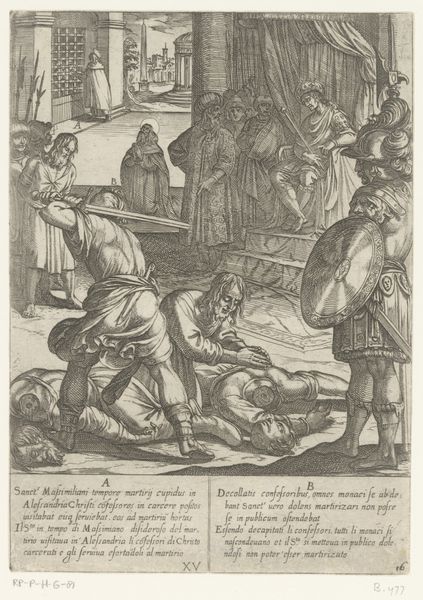
The Men of Ephraim Care for their Captives and Return Them to Jerico 1549
0:00
0:00
Copyright: National Gallery of Art: CC0 1.0
Editor: So, this is "The Men of Ephraim Care for their Captives and Return Them to Jericho" by Augustin Hirschvogel, created in 1549. It's a detailed etching, I believe. The mood is... well, almost tender, despite the stark lines and the context of captivity. The figures are so precisely rendered. What strikes you about this piece? Curator: You're right, there's a fascinating tenderness here. It almost feels… domestic, doesn’t it? Even though it depicts a scene from the Old Testament, about returning captives of war. What’s compelling is how Hirschvogel humanizes the victors. They're not gloating; they're bathing wounds, offering assistance. I wonder, did that sense of responsibility speak to something larger at the time? It was, after all, the Reformation era in Europe. Do you think we could connect some threads to unpack that relationship a little bit? Editor: That’s an interesting point – Reformation. It adds a layer, doesn't it? It's more than just a historical scene. It's a statement, perhaps, about grace and reconciliation? Curator: Exactly. Hirschvogel wasn't just illustrating a Bible story. He was also crafting an argument about morality, civic duty, and maybe even religious tolerance. The crisp detail, that hyper-realistic linework, serves a narrative that asks for thoughtful reevaluation and invites consideration, like we're actively participating in these events as witnesses. But it is still up to our interpretation. I believe Hirschvogel left breadcrumbs in there and it's always a lovely surprise when one figures them out. What else did you find as remarkable or engaging, my young inquisitive friend? Editor: Well, seeing the historical context definitely changed how I view the artwork, that it's also about values, rather than just history, opens a world of interpretations for me. I'll be thinking about this for a while. Thanks for this insightful exploration. Curator: Absolutely, anytime. Never stop looking beneath the surface of things.
Comments
No comments
Be the first to comment and join the conversation on the ultimate creative platform.













